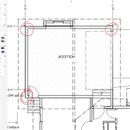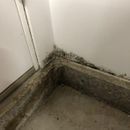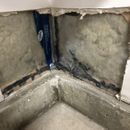Condensation in a heated and insulated garage
I have some condensation on the inside corners of my heated garage.
I live in North Vancouver, BC. I have a heated and insulated attached garage. (R23 Roxul in the wall, R44 Of Roxul in the ceiling, poly vapour barrier sealed at all edges with acoustical sealant and blue Tuck Tape at all seams and penetrations.) There is 6” of exposed concrete stub wall that the framing sits on. The garage is heated with a vented natural gas radiant tube heater. There is a 4” fresh air intake. We park a car in the garage.
I just noticed there is condensation on the inside of the three exterior corners of the concrete stub wall.I assume it is condensation because until I finished the interior of the garage, there were no leaks. I opened the worst corner and peeled back the vapour barrier. The sill plate and the insulation are dry.
How to fix this?
I just plugged in a dehumidifier because we do get a lot of rain and then park a wet car inside the garage so that can help a bit but what should I do with the short section of exposed concrete stub wall? What is the best way to insulate without adding a lot of bulk?
Thank you,
Aaron
PS. The black behind the v.b. Is just a smear of acoustical sealant when I peeled back the poly.
GBA Detail Library
A collection of one thousand construction details organized by climate and house part












Replies
I would consider exterior insulation of the foundation stem wall, GPS, EPS, or Roxul insulation boards, at least for part of your insulation. You need less rigorous fire protection of the insulation in that location.
Depending on your electricity cost, HRV might get you the dehumidification at a lower energy cost than the dehumidifier, but a really good, efficiency dehumidifier can be a reasonably economical way to add add as well as providing dehumidification.
I suppose the comfort of parking in the garage is more on rainy days than on dry days, but parking outside until the car is a little less wet would help too.
Thank you Charlie. I did think that exterior insulation might help. I live in a relatively mild climate so I am not too concerned about adding the optimal insulation. I assume i would need just enough insulation to provide a break, 1/2' to 3/4' of EPS.
Would an ERV provide better dehumidification than a HRV?
And it would have to be a very small one as my garage is only 4300 cubic feet.
As for leaving the car outside to dry off, in the winter, I could be waiting a long time...
Have you tried a fan(s)? Poor air circulation in corners adding to temp woes?
Seems like "natural gas radiant tube heater" may benefit from some air movement (ceiling fan or other)?
Corners (especially low corners) are geometrically prone to being cold, large surface area to volume and heat rises. Insulation at the corners may help. Have you used a handheld temperature gun to get a temp profile between corners and other portions of concrete?
Also, FWIW, there's an old post: https://www.greenbuildingadvisor.com/question/mysterious-moisture-in-garage with a response:
Martin Holladay | Oct 15, 2018 10:03am | #1
Rob,
Your two suggested theories -- condensation or wicking -- are certainly possible. If you closely observe the weather conditions, you should be able to determine the mechanism involved.
The most common time for condensation is when warm (especially warm and humid) weather follows a cold spell.
The most common time for wicking is immediately after a rain.
To reduce wicking, you need (a) to keep the exterior grade below the top of the slab, and (b) to make sure that the grade slopes away from the garage on all four sides, and (c) to maintain (if possible) wide roof overhangs.